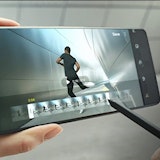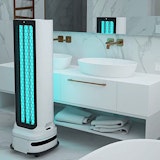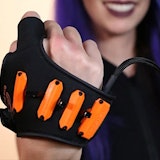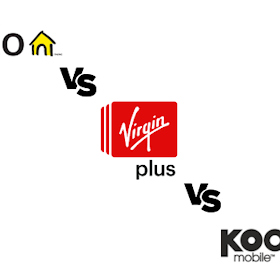
LG is officially exiting the mobile phone industry. Come July 2021, it will cease its smartphone business. The former wireless giant leaves behind a legacy of cell phones that competed with the best yet were often far more affordable than similar models from its competitors. Although Samsung cemented itself as the dominant Android smartphone brand many users chose by default, LG often led the pack with inventive designs and industry-first features.
WhistleOut Canada’s writers have reviewed many LG smartphones over the years and seen steady innovation over the life of LG Mobile. We highlight ten of our favourite features that pushed the limits of what a cell phone could do… even if it sometimes pushed a bit too far.

LG Prada: The Smartphone Apple Copied
Okay, Apple didn’t really copy the LG Prada. The first-gen Apple iPhone was announced a mere month after LG unveiled the Prada model. Both phones featured a capacitive screen that responded to your fingertip instead of needing a stylus pen. Considering that Apple sued Samsung for copying the iPhone design, it’s enlightening to know that the company wasn’t even first to market with a capacitive screen smartphone; that was LG.
With plastic casing and an operating system you’ve never heard of, the LG Prada never really fit the profile of a “luxury item.” However, the LG Prada claimed the coveted title of "Premium Smartphone" just before the iPhone would steal it away forever.

LG Chocolate BL40: Ultra-Widescreen Display
The long screen on the LG Chocolate BL40 doesn’t look so much out of place today. But back when most smartphones used nearly square displays showing several apps, the 4-inch 21x9 aspect ratio on the LG Chocolate presented a dozen or more icons. A narrow design and glossy black finish gave the phone a premium feel when most contemporary phones were still chunky and utilitarian.
The LG Chocolate BL40 didn’t run the more popular Android OS, and its performance couldn’t hold up to premium competitors. However, it was surely one of the most attractive smartphones ever created. The stylish design of LG’s final flagship smartphone, the LG Velvet 5G, is said to be inspired by the LG Chocolate BL40.

LG Google Nexus 4: Low-priced Premium Smartphone
Google partnered with LG to manufacture the Nexus 4 smartphone following previous development projects with Samsung and HTC. Despite premium hardware performance and the versatile Android operating system, the Nexus 4 was priced hundreds of dollars less than competition. This didn’t sit well with companies that also produced Android-based smartphones, so the next year Google returned to a premium pricing model.

LG G2: Power/Volume Rocker
The LG G2 updated the popular LG Optimus G with a faster processor, full HD resolution display and improved battery life. But what made this model truly innovative was moving the power button and volume rocker to the back of the device. Sitting where many phone users already rest their index finger, a quick tap set the volume or locked/unlocked the device. It’s just such a natural placement for these physical buttons that the feature remained on LG flagship phones for two more years until the LG G5 replaced it with a rear fingerprint scanner.

LG G4: Manual Camera Mode
The flagship LG G4 handed the controls over to the photographer with its introduction of manual camera mode. Even though Apple released a manual mode with iOS 8 several months earlier, adding the ability to control the 16MP camera’s ISO, focal depth, and white balance on a QuadHD display even impressed professional photographers at the time. Eventually, ThinQ AI software to do all the heavy lifting and optimize photos in real time. Until then, LG was one of the first to show off what its camera hardware could do by letting the user control the photography.

LG G5: “Friends” Accessories
By 2016, tech companies (including LG) started looking for clever, new ways to enhance the smartphone experience. The LG G5 was released alongside a suite of exclusive “LG G5 & Friends” accessories. Some of these attachments took advantage of the phone's removable base. A quick-release button on the side would pop off the bottom, allowing the user to attach a camera or 32-bit Hi-Fi amplifier. Other “G5 Friends” accessories included a portable 360-degree handheld camera and VR headset. Few of the “Friends” were released to the North American market and most were not considered to be very… well… good.
Later the same year, Motorola released the Moto Z smartphone line, which boasted hot-swappable “moto mods” accessories and was forward-compatible to the next three versions. Four years later, the Moto z4 still supported moto mods released since 2016. By comparison, the few “G5 Friends” accessories released by LG quickly disappeared from the market in less than a year.

LG G5: Ultra Wide-angle Camera
Hidden in the shadow of the flashy modular design and “G5 Friends” accessories was one of the most successful innovations on this list—the ultra-wide-angle lens. While most phones let you zoom in digitally, only the LG G5 allowed you to zoom out. A good ultra-wide camera lens lets you capture a bigger landscape, take super close-up macro photos, or get a picture of your whole family in a small space. Just a few years after the LG G5 released, even the cheapest smartphones feature multiple camera lenses on the rear, but the LG G5 was the first to make it mainstream.

LG V20: Secondary Ticker Display
The LG V-series smartphones always stood out from the flagship G-series by featuring oversized, “phablet”-style displays and experimental features. The most unique feature on the LG V20 was the second, always-on display. At a time when running a smartphone display could drain the battery in a matter of hours, the 1040x160 pixel screen sat just above the primary display and off to the side of the front-facing camera.
The wide touchscreen could be set to display the time, call details, music controls, app shortcuts or even a customized message. It was ultimately rendered obsolete by high-efficiency technology that allows full-screen displays to show critical information with little drain on the battery. But LG wasn't done with multiple screen smartphones...

LG V50/G8X: Dual Screen Support
While Samsung, Huawei and Motorola were trying to be the first to the market with a foldable smartphone, LG beat all of them on a technicality. The LG V50 is a powerful smartphone in its own right, but the Dual Screen accessory also made it the first foldable smartphone on the market in North America. Later the same year, the LG G8X Dual Screen became the first foldable smartphone in the Canadian market.
Instead of relying on complex and expensive bendable displays, LG’s innovative Dual Screen accessory wraps around the phone and gives it a clamshell style with a second full-size display. The second screen matched the first in display resolution, colour reproduction and even a “camera notch” (which didn’t really have a camera but was included for visual balance).
Unfortunately, the second display didn’t weigh the same, so the centre of balance was off. Also, opening the 360-degree hinge blocked the powerful rear camera. It was popular enough that LG included the Dual Screen accessory on three LG models including the LG V60 5G.

LG Wing: “T” is for Two Screens
The two biggest problems with the Dual Screen accessory are undone by the LG Wing: the primary screen twists sideways—keeping the centre of balance in the visual centre of the device—and a second, square screen is revealed without blocking the 64MP camera on the back.
The imagination runs wild thinking of ways to multitask using the unique "T" shape of the LG Wing, but poor support by third-party apps limits that feature. It was never released in Canada, and the high price tag and mediocre performance limit the LG Wing to a market that exclusively wants that unique second display. It’s undoubtedly the most innovative design by a company that excelled at creating innovative smartphones, even if it would ultimately be its swan song.
Farewell to LG Mobile
Not all of LG Mobile’s inventions were winners, but each one fashioned LG as a leader in smartphone design. On a personal note, the LG G4 was the first smartphone I reviewed, and that review led my career towards writing about cell phones full time. I’ve always enjoyed trying out LG Mobile’s newest innovations. Although the company is no longer making smartphones, existing LG smartphones are still available to buy, and LG commits to supporting software updates for the life of the phones.
Avoid the cheaper LG K-series smartphones which underperform and see if you can find a good deal on the popular LG Velvet 5G, LG G8X or my personal favourite, the LG V60 5G.
Related Articles
Find Better Phones and Plans
Hundreds of cell phone plans unpacked. All the facts. No surprises.



































